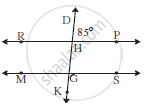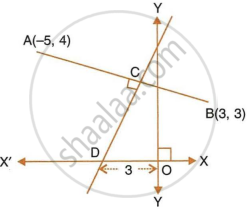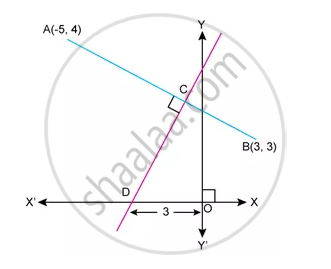Advertisements
Advertisements
Question
Three vertices of a parallelogram ABCD taken in order are A(3, 6), B(5, 10) and C(3, 2), find:
- the co-ordinates of the fourth vertex D.
- length of diagonal BD.
- equation of side AB of the parallelogram ABCD.
Solution
i. Let (x, y) be the co-ordinates of D.
We know that the diagonals of a parallelogram bisect each other.
∴ Mid-point of diagonal AC = Mid-point of diagonal BD
`=> ((3 + 3)/2, (6 + 2)/2) = ((5 + x)/2, (10 + y)/2)`
`=> (3, 4) = ((5 + x)/2, (10 + y)/2)`
`=> (5 + x)/2 = 3`
`=>` 5 + x = 6
`=>` x = 1
And `(10 + y)/2 = 4`
`=>` 10 + y = 8
`=>` y = –2
∴ Co-ordinates of D are (1, –2).
ii. Length of diagonal BD = `sqrt((1 - 5)^2 + (-2 - 10)^2)`
= `sqrt((-4)^2 + (-12)^2)`
= `sqrt(16 + 144)`
= `sqrt(160)`
= `4sqrt(10)` units
iii. Slope of side AB = m = `(10 - 6)/(5 - 3) = 4/2 = 2`
Thus, the equation of side AB is given by
y – 6 = 2(x – 3)
i.e. y – 6 = 2x – 6
i.e. 2x – y = 0
i.e 2x = y
APPEARS IN
RELATED QUESTIONS
Write the equation of the line passing through the pair of points (2, 3) and (4, 7) in the form of y = mx + c.
Find the slope and y-intercept of the line:
ax – by = 0
Find the slope and y-intercept of the line:
3x – 4y = 5
Is the line 3x + 4y + 7 = 0 perpendicular to the line 28x – 21y + 50 = 0?
Find the equation of the perpendicular bisector of the line segment obtained on joining the points (6, −3) and (0, 3).
The points A, B and C are (4, 0), (2, 2) and (0, 6) respectively. Find the equations of AB and BC. If AB cuts the y-axis at P and BC cuts the x-axis at Q, find the co-ordinates of P and Q.

In the adjoining figure line RP ||line MS , line DK is a transversal . If ∠DHP = 85° find ∠RHG and ∠HGS.
Line PQ is parallel to line RS where points P,Q,R and S have
co-ordinates (2, 4), (3, 6), (3, 1) and (5, k) respectively. Find value of k.
Find:

- equation of AB
- equation of CD
Find Equation of CD

